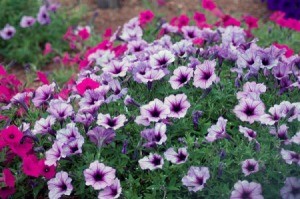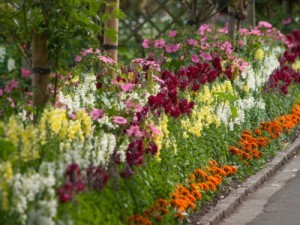

Annuals are the flowering powerhouses of the plant world, and fertilizer is the fuel that keeps their engines firing. Knowing how to fertilize them is important, because unlike perennials, annuals don't get a second chance. Proper fertilization, especially in the first six to eight weeks after planting, has a huge impact on the quality and quantity of their blooms. Once your annuals start blooming, a proper feeding schedule will keep them blooming vigorously for the rest of the growing season.
Plants' roots absorb the nutrients they need from the soil. If a needed nutrient isn't present in the soil in sufficient quantities, or it is present in a form that can't be readily absorbed (for example, a pH imbalance will cause nutrients to become unavailable), you need to either add it as fertilizer or correct the soil conditions that are preventing the nutrient from being absorbed.
Most soils (in combination with sunshine and rain) already contain enough nutrients for healthy growth. But how do you know for sure? To be absolutely sure you can have your soil tested. It will tell you which nutrients, if any, your soil is lacking so you can work it into the soil before planting. Even then you will still have to apply other nutrients later on.
Plant nutrients can be divided into two basic groups: micro-nutrients (those they need in small amounts) and macro-nutrients (those they need in large amounts). The "big three" macro-nutrients include nitrogen, phosphorus and potassium. Each promotes the growth of plants in a different way:
Nitrogen (N): Nitrogen promotes the growth of leaves and stems. Plants putting out new growth benefit from fertilizers with higher ratios of nitrogen relative to the other nutrients. Compared to phosphorus and potassium, nitrogen is less stable in the soil - it washes away more easily when you water. Fortunately, plants usually respond quickly to applications of nitrogen, so a nitrogen deficiency in the soil is easy to correct by adding fertilizer.
Phosphorus (P): Phosphorus encourages flower, fruit, and seed production. It enhances floral displays in ornamentals and improved blossom and fruit set in fruit-producing plants. Flowering plants like annuals need a higher ratio of phosphorus to realize their blooming potential.
Potassium (K): Potassium is necessary for healthy roots and resistance to disease. It's important for all plants, including annuals, but it's especially critical for edible root crops such as carrots, beans, and squash.
The label on commercial fertilizers (organic and synthetic) contains a three-number NPK ratio. The first number is the percentage of nitrogen; the second the percentage of phosphate; and the third, the percentage of potash (potassium). For your flowering annuals, an all-purpose fertilizer with a ratio of 5-10-5 or 10-10-10 will keep your plants blooming vigorously all season long.
Some gardeners prefer switching to a low nitrogen fertilizer after their annuals reach full bloom, thinking that the nitrogen will encourage leaf growth at the expense of flowers. If you're deadheading regularly (removing spent blooms), consistent applications of nitrogen won't be a problem - in fact it will only help encourage continuous blooms.
Annuals growing in containers need more food than those growing in the ground. That's because every time you water, some of the nutrients from the soil are flushed out the drainage holes. Liquid fertilizers are ideal for feeding potted annuals. Give them a shot of half-strength liquid fertilizer once every week or two when you water and your plants should bloom like crazy!